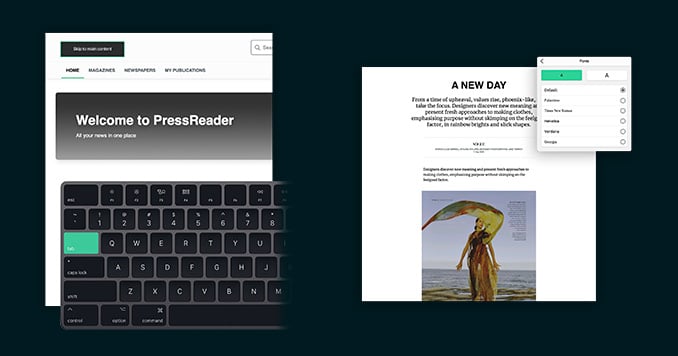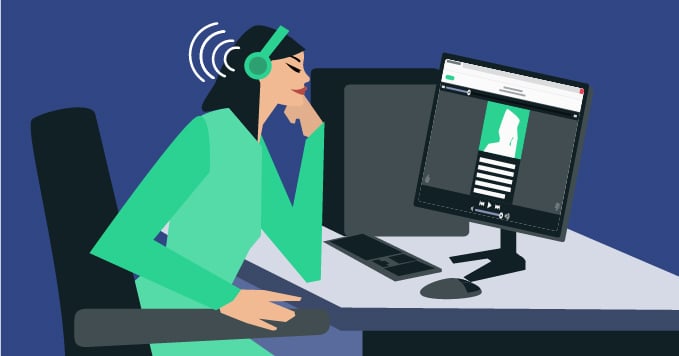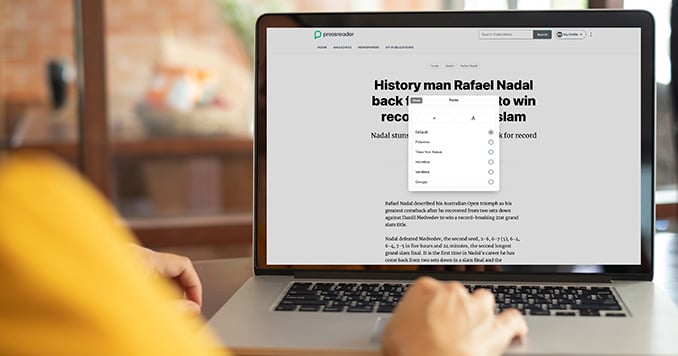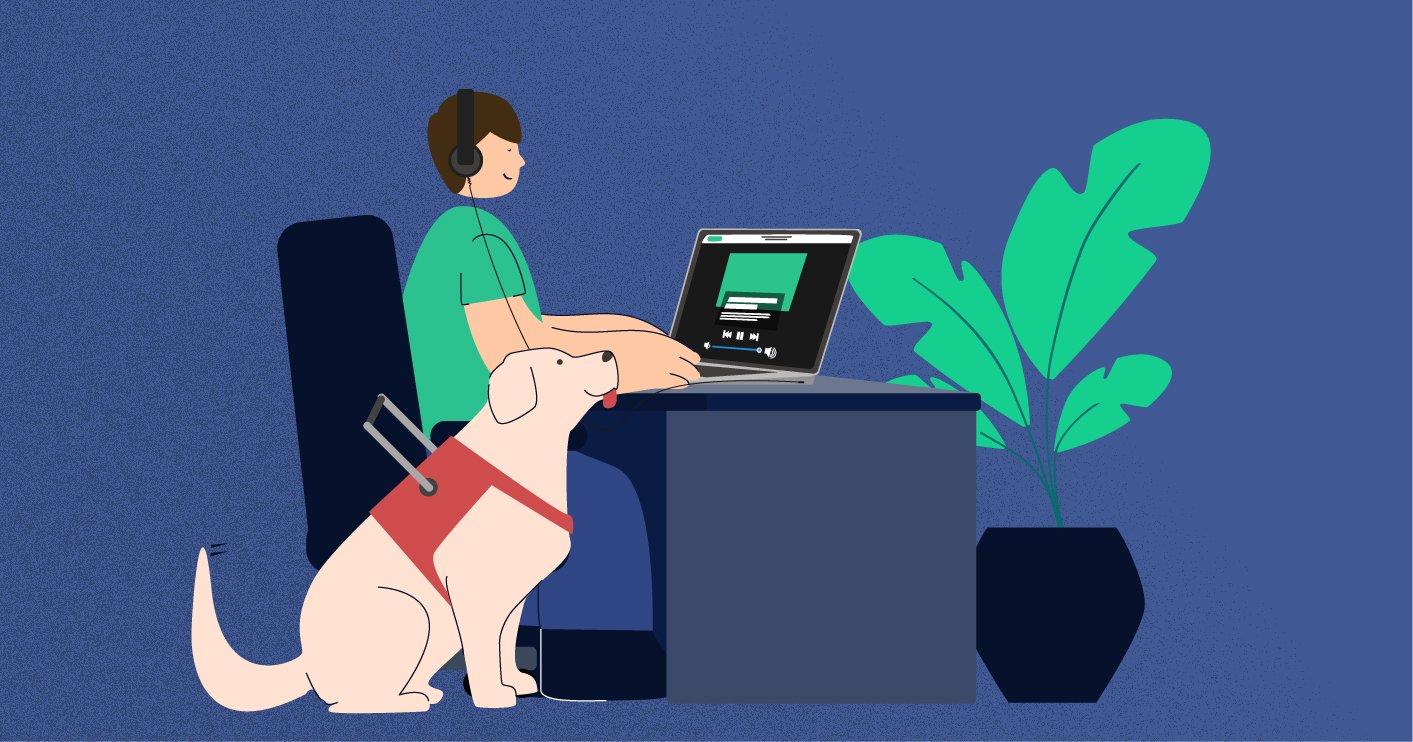At PressReader, one of our mandates is to make sure that everyone has access to newspapers and magazines from around the world — and we mean everyone.
This mandate is part of what inspired our team to develop PressReader Accessibility, a set of features that make it easier for individuals with various accessibility needs to read the extensive content available on our platform. With lots of help along the way, and a team that was truly dedicated to this project, we designed accessibility features that are changing how people access the articles they want to read on a daily basis.
Here’s how we did it.
See also:
- How the South African Library for the Blind is making content accessible with PressReader
- Public libraries play a crucial role in sustainable development
- How Edinburgh City Libraries protects and empowers its most vulnerable populations
A timely reminder
Like many tech companies that build apps and platforms for consumers, the team at PressReader needed a nudge in the right direction when it came to focusing on accessibility. For us, it came in the form of a review from the National Network for Equitable Library Services (NNELS).
Incorporating assistive technology was always on our roadmap, but it was delayed due to other commercial priorities. When we partnered with the organization to review our product, we realized just how much work we had to do. In their report, NNELS identified a number of issues in our web and mobile applications, showcasing that we had a lot of work to do. In fact, they gave us a D- rating for accessibility compliance for print disabilities.
“The PressReader application for iOS and Android, as well as the website, have several accessibility issues that our testers identified as barriers for the average user. Testers could not easily navigate the mobile apps and the website due to all the unlabeled controls and buttons, as well as the complex interfaces. This means that users relying on assistive technology cannot fully enjoy the impressive collection of resources that PressReader offers. The recommendations in this report are aimed to help with improvements that would make this app a viable option for users who have print disabilities.”
- 2019 Accessible Testing of PressReader report
The comprehensive report from NNELS gave us a lot to think about. People with visual and motor disabilities are so often barred from accessing the information and content they’re interested in, and we had an opportunity to change that within our platform.
Our technology had been built over years of development and was ultimately quite complex, making it difficult to introduce accessibility features directly into it. Instead, we opted to build a brand new product from the ground up, with accessibility at the heart of it.
Next, we had to gather the right team for the job. Many of the people who put their hands up for this project had direct or indirect ties to people who used assistive technology — and that insight was invaluable. We formed a passionate, cross-functional team that included folks from our library sales, product, R&D and marketing departments. Together, they put all their energy into designing, building and testing a product that would do our readers justice.

How we did it
When setting our intentions for this new product, we had some key considerations we wanted to keep top of mind:
- The reading experience shouldn’t be compromised. Where possible, we wanted to ensure the text was still complemented with visuals or design elements that helped tell the story.
- The interface had to be clean, fast and attractive — without losing the core PressReader functionalities.
In short, we had to find a way to make the solution accessible to as many people as possible. This is why we named the initiative Project Pervasive; it would include and impact everyone.
The timing for this project was ideal. We were able to align the development of PressReader Accessibility with other simplification projects we were working on at the time. These features, which were built with modern development standards, helped us move quickly and acted as the perfect foundation for what’s now a WCAG 2.1 compliant technology. In the future, we plan to adapt the core PressReader product to this more simplified and accessible approach, so that everyone using the platform has the same consistent experience.
As the technology was built, we tested it on the different devices and e-readers that individuals are using in the real world. We worked closely with Accessible Web — who helped us certify our new product with their expert validation tools — to ensure we were meeting all WCAG 2.1 requirements. We also ran beta tests with some of our partners, like the South African Library for the Blind. Patrons and team members at the library provided us with indispensable feedback that have shaped how the end product works.
A step in the right direction
As we built PressReader Accessibility, we realized that we needed to do way more than just improve the experience for people with visual impairments. We had to factor in any challenges with typing, speaking, mobility, color differentiation, and memory. This is what shaped the features we designed for our web experience — and what we plan to incorporate in the mobile app experience in the future.


The features include:
- Keyboard navigation that allows readers to browse publications using the TAB and ENTER keys.
- Font enhancement so that readers can enlarge or shrink the font size on our publications to fit their unique needs.
- Article view that extracts text from the original newspaper or magazine replica and presents it in a way that’s simple to navigate.
- Compatibility with various popular screen readers on the market. It’s also available through the internet browser on desktop and mobile devices.
We're proud that with these features, hundreds of organizations can give more of their customers access to great content. In particular, PressReader Accessibility has helped many American library partners fulfill Section 508 of the Rehabilitation Act which requires all federal agencies to give disabled employees and members of the public access comparable access to information.
The added bonus? With our access to over 7,000 publications, PressReader acts as a portal into multiple magazines and newspapers that may not have the resources to incorporate assistive technologies into their digital offerings. This, in turn, helps us take one step further in our mandate of media literacy.
Since we’ve launched the new features, the NNELS has once again reviewed our platform in a new report. In it, they acknowledge that we’ve improved in many areas and are much better positioned to serve our readers with print disabilities.
“PressReader has made a considerable effort to make the website flexible and to make it work for as many people as possible. This is a big step forward for PressReader, and using it with a screen reader is likely to be an enjoyable experience for many users, especially when remaining accessibility issues are addressed. In a world of bloated and cluttered news sites that never quite seem to manage consistent navigation or heading structure, PressReader’s accessibility mode offers a much smoother experience and easy access to many publications in one place. We look forward to all the accessible improvements be integrated in the main website.”
- 2020 Accessible Testing of PressReader report
Carrying accessibility into the future
For us, the work doesn’t stop here. Having developed this new product, and learned a lot along the way, the team at PressReader is more aware than ever of the gaps we still have to address. To start, we’ll be making our purchase pages more accessible, as well as enhancing mobile web and app accessibility. We’re also working on rolling out a consistent experience across channels so that our assistive technologies don’t feel disconnected from the rest of the PressReader platform.
We’re excited to continue learning as we do our part to improve access to reading for everyone.
Change the way you offer newspapers and magazines to your patrons. To see our accessibility features in practice, get in touch and request a demo.






